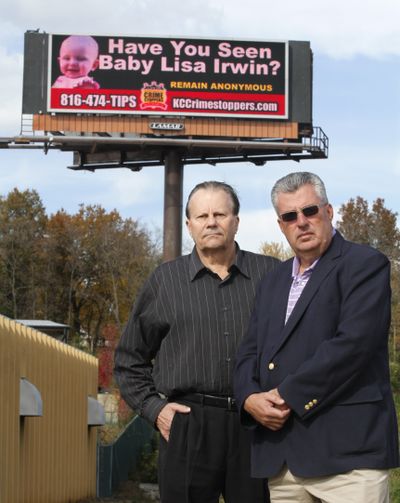Billboards seen as crime solver and as eyesore
Digital ones criticized as driver distraction

KANSAS CITY, Mo. – Nearly a decade ago, a suburban Kansas City man desperately searching for his teenage daughter’s killer divined an idea: Place a “wanted” poster with the suspect’s picture on a billboard.
A year later, Leawood, Kan., resident Roger Kemp got his wish and investigators got their man. Two anonymous tipsters who had seen the Kansas City billboards recognized the photo and contacted police.
Today, law enforcement agencies nationwide say billboards – especially digital ones – have become a valuable tool in their high-tech crime-fighting arsenal. Last week, more than a dozen electronic billboards began flashing pictures of little Lisa Irwin, the missing Kansas City baby who was 10 months old when her parents reported her missing Oct. 4.
Kansas City police said Friday they had pursued 934 of the 1,059 tips they’ve received, but still have no solid leads.
Lamar Advertising Co. has put Lisa’s picture, a phone number and information about a $100,000 reward on its 15 electronic billboards in the Kansas City metropolitan area as a public service, CEO Bob Fessler said.
The National Center for Missing and Exploited Children has a deal with digital billboard operators nationwide in which the organization can override the messages on the signs and replace them with Amber Alerts whenever they’re issued. That happened on the day Lisa disappeared.
The Outdoor Advertising Association of America Inc. estimates the FBI will use roughly 40 million donated billboard slots in 2011, each lasting eight seconds.
Ken Kline, vice president with the Outdoor Advertising Association, said that since so many agencies – local police, FBI, U.S. Marshals Service and others – are using the billboards to catch fugitives, there’s no way to quantify how many people have been apprehended through their use. He said a “national estimate of multiple hundreds would be conservative.”
But acceptance of digital billboards is not universal. Kansas City has a moratorium in place restricting new billboards, and cities nationwide are grappling with an issue some feel is destroying the beauty of their neighborhoods and countryside while also distracting drivers.
“We receive a lot of complaints from individuals who live in neighborhoods, and motorists who are concerned about the additional distractions and dangers billboards pose,” said John Regenbogen, executive director of Scenic Missouri, which touts billboard control as one of its top issues. “When digital billboards come into a community, they’re often met with outcry from residents.”
They also keep missing children in the public eye. Fessler said his company, which donated those first billboards for Kemp’s campaign in 2003, wanted to help gather tips in the Lisa Irwin search by keeping her image displayed on the billboards.
“After the Kemp case, we got a lot of phone calls about anything from missing people to cold cases,” Fessler said. “We treat it as a public service. We don’t charge for it.”
Fessler’s company has been embroiled in a multiyear dispute with Kansas City over electronic billboards after the city banned them in 2007. The city now has a moratorium that allows the handful of digital billboards to remain, but places strict restrictions on new signs.